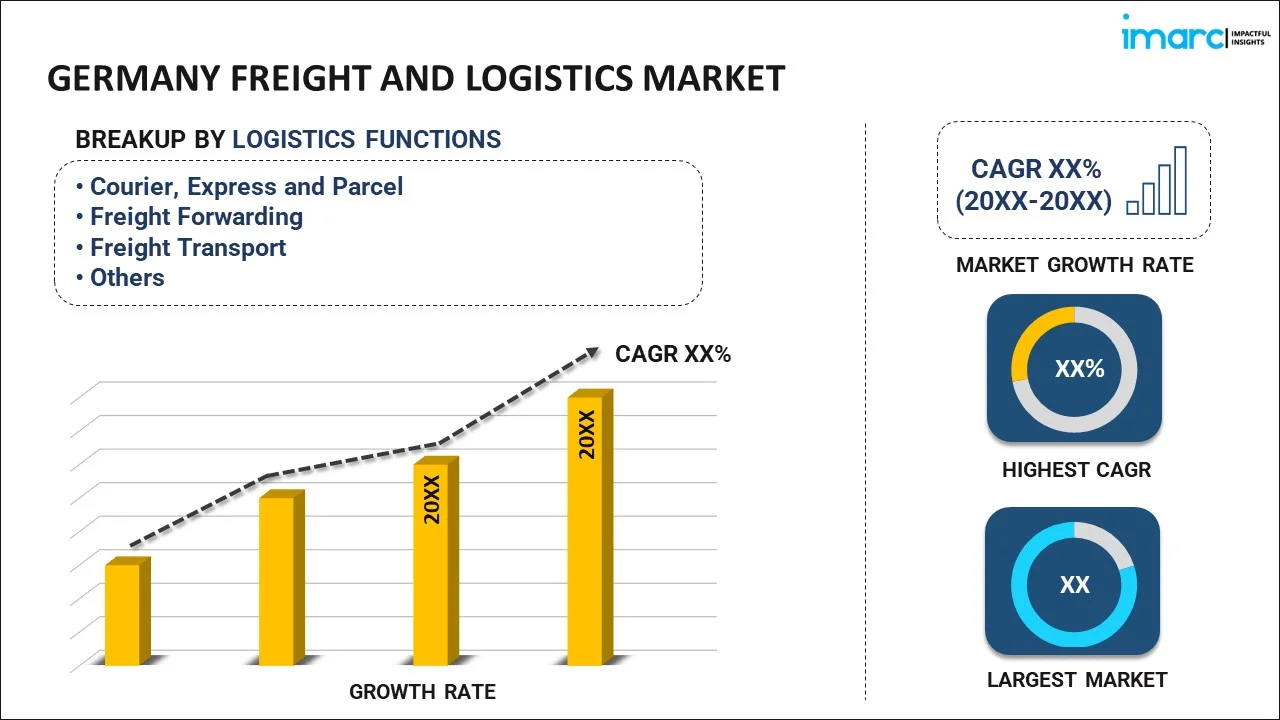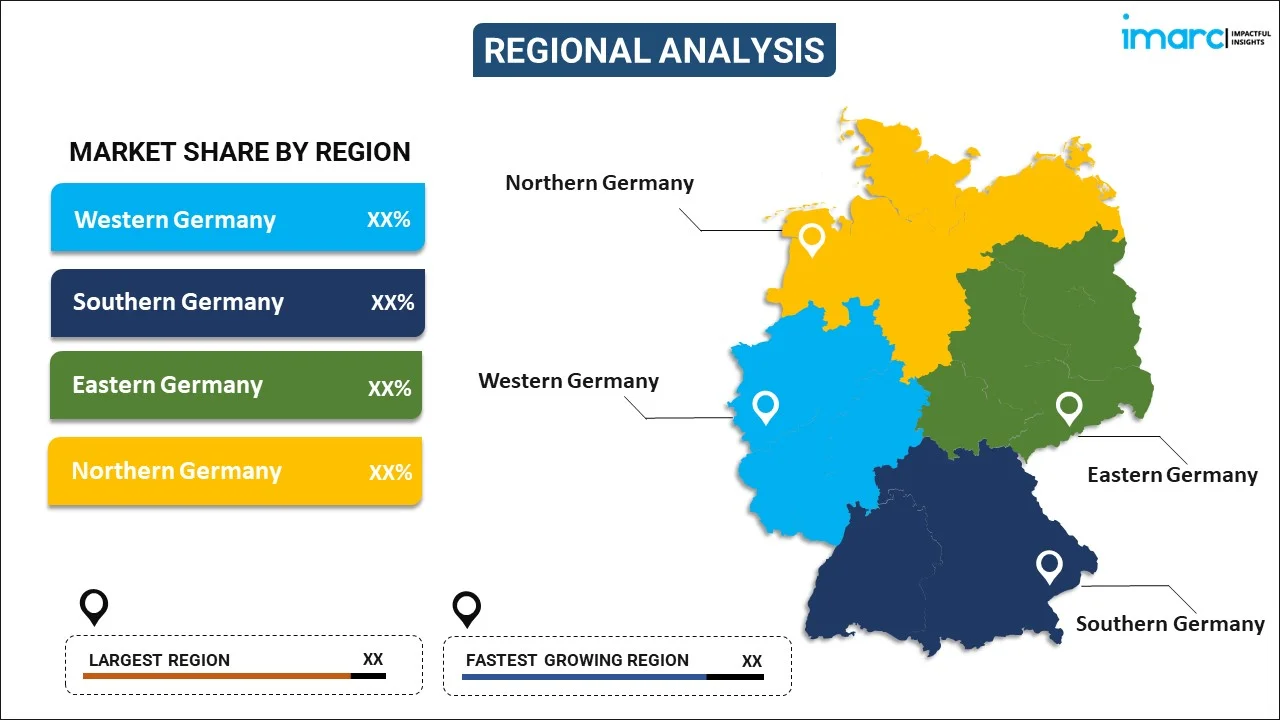
Germany Freight and Logistics Market Report by Logistics Function (Courier, Express and Parcel, Freight Forwarding, Freight Transport, Warehousing and Storage, and Others), End Use Industry (Agriculture, Fishing and Forestry, Construction, Manufacturing, Oil and Gas, Mining and Quarrying, Wholesale and Retail Trade, and Others), and Region 2025-2033
Germany Freight and Logistics Market Overview:
The Germany freight and logistics market size is projected to exhibit a growth rate (CAGR) of 5.47% during 2025-2033. The market growth is being driven by several factors, including the launch of electric trucks, the increase in fuel economy in Germany, and the country’s status as the largest importer of natural gas.
|
Report Attribute
|
Key Statistics
|
|---|---|
|
Base Year
|
2024 |
|
Forecast Years
|
2025-2033
|
|
Historical Years
|
2019-2024
|
| Market Growth Rate (2025-2033) | 5.47% |
Germany Freight and Logistics Market Trends:
Launch of Electric Trucks
Germany is advancing sustainable transportation with several private trucking companies introducing electric trucks. For instance, Maersk, a leading innovator in integrated and sustainable logistics solutions, announced a new initiative to reduce GHG emissions in hinterland container transports by purchasing 25 state-of-the-art Volvo FH electric trucks in Germany. This strategic investment highlights the company's dedication to decarbonizing global logistics and achieving net-zero emissions by 2040 across all business areas and modes of transport. In addition this, Hamburg authorities announced an investment of 18 million euros into the city’s experimental autonomous vehicle programme for public transport. The investment came from the German Federal Ministry for Transport.
Rising Fuel Prices in Germany
German consumers experienced the fastest price increases, primarily driven by the sharp rise in energy and food prices following the Russia-Ukraine War. Moreover, Germany is one of the world's largest natural gas importers. According to an article published on Clean Energy Wire in October 2023, Germany is expecting a fuel price increase starting in 2027 due to the EU emissions trading system. The anticipated rise includes an additional 38 cents per liter of petrol and about 3 cents per kilowatt-hour of natural gas compared to 2026. Germany needs to devise a plan to address these potential price hikes as it transitions from its national carbon pricing for transport and heating fuels to the EU-wide emissions trading system (ETS II) in 2027. The European Union has decided to implement a second emissions trading system for the transport and building sectors, alongside its existing system for energy and industry. Germany will need to align its current national CO2 pricing scheme with this new system. The German system is set to transition from a fixed-price model to a trading system with capped emissions by 2026, but Agora is advocating for this change to occur earlier, in 2025, with an established price corridor.
Germany Freight and Logistics Market News:
- In January 2024, Dachser launched a new product throughout Europe, "Targo on-site fix", which supports its customers’ omnichannel concepts and allows for complete flexibility when arranging delivery dates. It was a part of its plan to expand its B2C delivery services in Europe.
- In January 2024, Kuehne + Nagel announced its Book & Claim insetting solution for electric vehicles to improve its decarbonization solutions. Developing Book & Claim insetting solutions for road freight is a strategic priority for Kuehne + Nagel. Customers using Kuehne + Nagel's road transport services can now claim the carbon reductions of electric trucks, even when it’s not feasible to physically move their goods using these vehicles.
Germany Freight and Logistics Market Segmentation:
IMARC Group provides an analysis of the key trends in each segment of the market, along with forecasts at the country level for 2025-2033. Our report has categorized the market based on logistics function and end use industry.
Logistics Function Insights:

- Courier, Express and Parcel
- By Destination Type
- Domestic
- International
- By Destination Type
- Freight Forwarding
- By Mode of Transport
- Air
- Sea and Inland Waterways
- Others
- By Mode of Transport
- Freight Transport
- By Mode of Transport
- Air
- Pipelines
- Rail
- Road
- Sea and Inland Waterways
- By Mode of Transport
- Warehousing and Storage
- By Temperature Control
- Non-Temperature Controlled
- Temperature Controlled
- By Temperature Control
- Others
The report has provided a detailed breakup and analysis of the market based on the logistics function. This includes courier, express and parcel [by destination type (domestic and international)], freight forwarding [by mode of transport (air, sea and inland waterways, and others)], freight transport [by mode of transport (air, pipelines, rail, road, and sea and inland waterways)], warehousing and storage [by temperature control (non-temperature controlled and temperature controlled)], and others.
End Use Industry Insights:
- Agriculture, Fishing and Forestry
- Construction
- Manufacturing
- Oil and Gas, Mining and Quarrying
- Wholesale and Retail Trade
- Others
A detailed breakup and analysis of the market based on the end use industry have also been provided in the report. This includes agriculture, fishing and forestry, construction, manufacturing, oil and gas, mining and quarrying, wholesale and retail trade, and others.
Regional Insights:

- Western Germany
- Southern Germany
- Eastern Germany
- Northern Germany
The report has also provided a comprehensive analysis of all the major regional markets, which include Western Germany, Southern Germany, Eastern Germany, and Northern Germany.
Competitive Landscape:
The market research report has also provided a comprehensive analysis of the competitive landscape in the market. Competitive analysis such as market structure, key player positioning, top winning strategies, competitive dashboard, and company evaluation quadrant has been covered in the report. Also, detailed profiles of all major companies have been provided.
Germany Freight and Logistics Market Report Coverage:
| Report Features | Details |
|---|---|
| Base Year of the Analysis | 2024 |
| Historical Period | 2019-2024 |
| Forecast Period | 2025-2033 |
| Units | Billion USD |
| Scope of the Report | Exploration of Historical Trends and Market Outlook, Industry Catalysts and Challenges, Segment-Wise Historical and Future Market Assessment:
|
| Logistics Functions Covered |
|
| End Use Industries Covered | Agriculture, Fishing and Forestry, Construction, Manufacturing, Oil and Gas, Mining and Quarrying, Wholesale and Retail Trade, Others |
| Regions Covered | Western Germany, Southern Germany, Eastern Germany, Northern Germany |
| Customization Scope | 10% Free Customization |
| Post-Sale Analyst Support | 10-12 Weeks |
| Delivery Format | PDF and Excel through Email (We can also provide the editable version of the report in PPT/Word format on special request) |
Key Questions Answered in This Report:
- How has the Germany freight and logistics market performed so far and how will it perform in the coming years?
- What has been the impact of COVID-19 on the Germany freight and logistics market?
- What is the breakup of the Germany freight and logistics market on the basis of logistics function?
- What is the breakup of the Germany freight and logistics market on the basis of end use industry?
- What are the various stages in the value chai of the Germany freight and logistics market?
- What are the key driving factors and challenges in the Germany freight and logistics?
- What is the structure of the Germany freight and logistics market and who are the key players?
- What is the degree of competition in the Germany freight and logistics market?
Key Benefits for Stakeholders:
- IMARC’s industry report offers a comprehensive quantitative analysis of various market segments, historical and current market trends, market forecasts, and dynamics of the Germany freight and logistics market from 2019-2033.
- The research report provides the latest information on the market drivers, challenges, and opportunities in the Germany freight and logistics market.
- Porter's five forces analysis assist stakeholders in assessing the impact of new entrants, competitive rivalry, supplier power, buyer power, and the threat of substitution. It helps stakeholders to analyze the level of competition within the Germany freight and logistics industry and its attractiveness.
- Competitive landscape allows stakeholders to understand their competitive environment and provides an insight into the current positions of key players in the market.
Need more help?
- Speak to our experienced analysts for insights on the current market scenarios.
- Include additional segments and countries to customize the report as per your requirement.
- Gain an unparalleled competitive advantage in your domain by understanding how to utilize the report and positively impacting your operations and revenue.
- For further assistance, please connect with our analysts.
 Inquire Before Buying
Inquire Before Buying
 Speak to an Analyst
Speak to an Analyst
 Request Brochure
Request Brochure
 Request Customization
Request Customization




.webp)




.webp)












